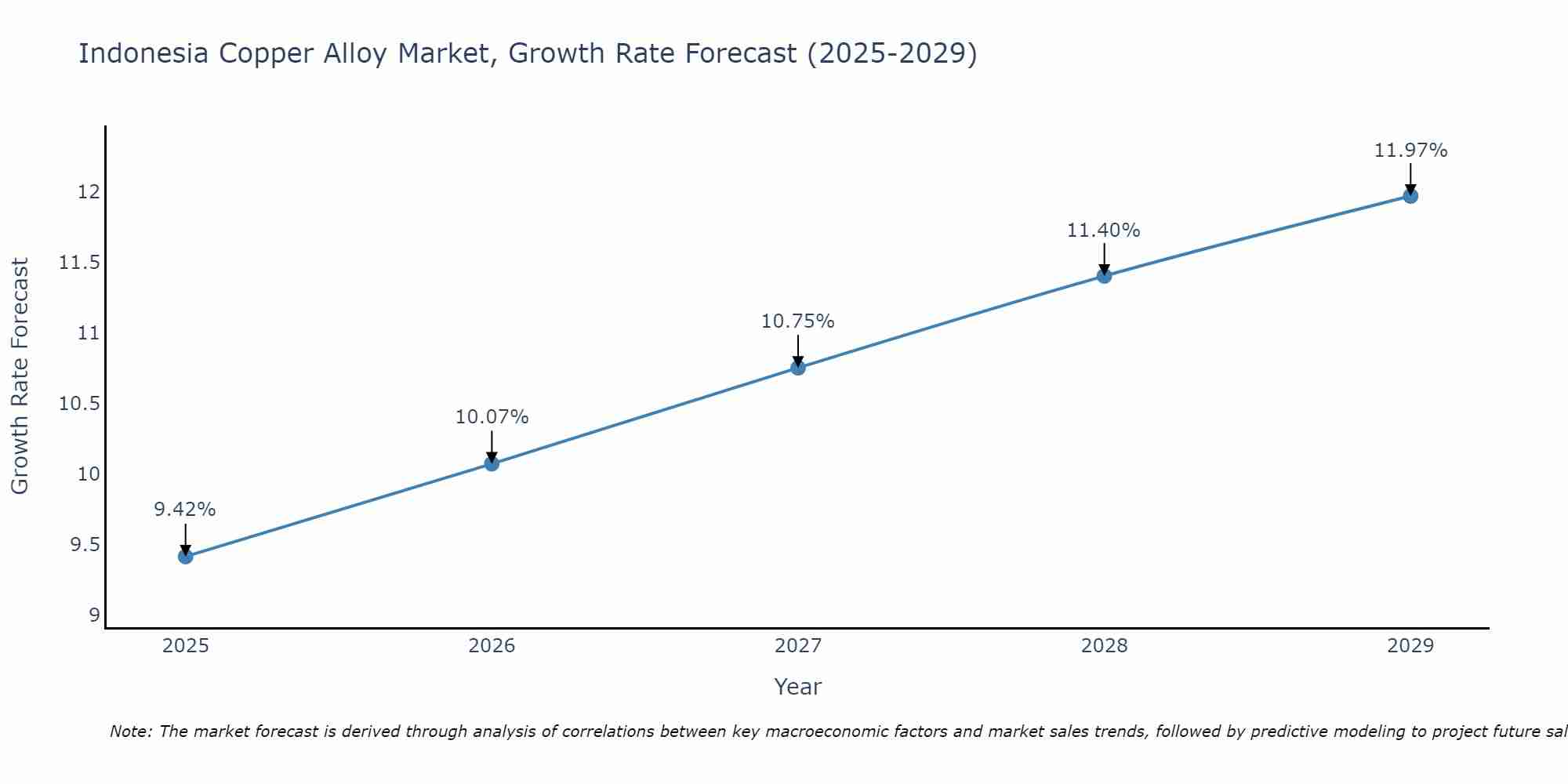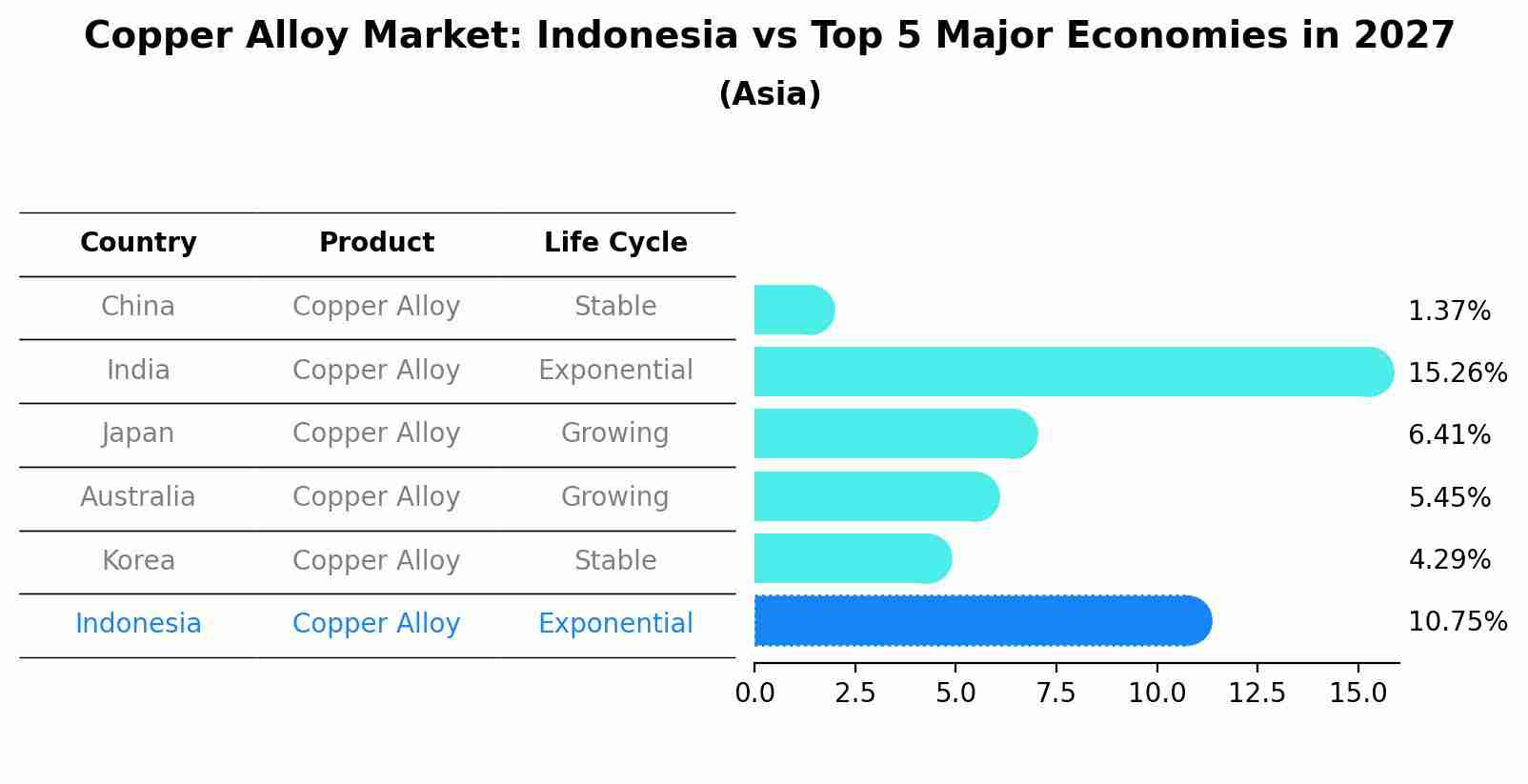Indonesia Copper Alloy Market (2025-2031) Outlook | Share, Analysis, Forecast, Revenue, Industry, Value, Trends, Growth, Size & Companies
| Product Code: ETC274168 | Publication Date: Aug 2023 | Updated Date: Aug 2025 | Product Type: Market Research Report | |
| Publisher: 6Wresearch | Author: Ravi Bhandari | No. of Pages: 75 | No. of Figures: 35 | No. of Tables: 20 |
Indonesia Copper Alloy Market Size Growth Rate
The Indonesia Copper Alloy Market is likely to experience consistent growth rate gains over the period 2025 to 2029. From 9.42% in 2025, the growth rate steadily ascends to 11.97% in 2029.

Copper Alloy Market: Indonesia vs Top 5 Major Economies in 2027 (Asia)
The Copper Alloy market in Indonesia is projected to grow at a high growth rate of 10.75% by 2027, within the Asia region led by China, along with other countries like India, Japan, Australia and South Korea, collectively shaping a dynamic and evolving market environment driven by innovation and increasing adoption of emerging technologies.

Indonesia Copper Alloy Market Synopsis
The copper alloy market size was valued at USD 2 billion in 2025 and it is anticipated that it will witness a significant CAGR of 4. 1% driven by increased infrastructural activities coupled with rising investment from developed countries into developing nations such as India and China primarily using these alloys for manufacturing components used within industrial machinery sector ranging from automobiles to aerospace & defense applications etc. , Industrial grade brass which includes compositions like red brass (C23000), cartridge brass (C26000) etc. , holds a major portion among different types available within this segment followed by bronze variants composed mainly out of silicon content alongwith copper based on specific end user requirement specifications
Drivers of the Market
Copper alloys find extensive use in electrical, transportation, and industrial sectors due to their unique properties like malleability, conductivity, and strength. The growth of these industries, along with the constant need for innovative materials, drives the demand for copper alloys.
Challenges of the Market
Variability in alloy composition and properties demands precise quality control, raising production complexity. Market awareness and acceptance of specific copper alloys can be limited, hindering growth.
COVID-19 Impact on the Market
The Indonesia Copper Alloy Market also faced considerable challenges due to the pandemic. Similar to the rivets market, disruptions in manufacturing and reduced industrial output had a direct impact on the demand for copper alloys. Industries that heavily rely on copper alloys, such as aerospace, automotive, and electronics, experienced a decline in production and demand. This, in turn, affected the consumption of copper alloys for various applications, ranging from electrical components to mechanical parts. Fluctuations in global trade and supply chain disruptions further complicated the market`s stability. Moreover, with uncertain economic conditions and reduced consumer spending, the demand for products made with copper alloys, such as consumer electronics and machinery, also decreased. The market for copper alloys thus faced challenges in maintaining steady growth and revenue during the pandemic.
Key Highlights of the Report:
- Indonesia Copper Alloy Market Outlook
- Market Size of Indonesia Copper Alloy Market, 2024
- Forecast of Indonesia Copper Alloy Market, 2031
- Historical Data and Forecast of Indonesia Copper Alloy Revenues & Volume for the Period 2021-2031
- Indonesia Copper Alloy Market Trend Evolution
- Indonesia Copper Alloy Market Drivers and Challenges
- Indonesia Copper Alloy Price Trends
- Indonesia Copper Alloy Porter's Five Forces
- Indonesia Copper Alloy Industry Life Cycle
- Historical Data and Forecast of Indonesia Copper Alloy Market Revenues & Volume By Type for the Period 2021-2031
- Historical Data and Forecast of Indonesia Copper Alloy Market Revenues & Volume By Rods & Wires for the Period 2021-2031
- Historical Data and Forecast of Indonesia Copper Alloy Market Revenues & Volume By Plates & Strips for the Period 2021-2031
- Historical Data and Forecast of Indonesia Copper Alloy Market Revenues & Volume By Tubes for the Period 2021-2031
- Historical Data and Forecast of Indonesia Copper Alloy Market Revenues & Volume By Other for the Period 2021-2031
- Historical Data and Forecast of Indonesia Copper Alloy Market Revenues & Volume By Application for the Period 2021-2031
- Historical Data and Forecast of Indonesia Copper Alloy Market Revenues & Volume By Electrical Industry for the Period 2021-2031
- Historical Data and Forecast of Indonesia Copper Alloy Market Revenues & Volume By Transportation Industry for the Period 2021-2031
- Historical Data and Forecast of Indonesia Copper Alloy Market Revenues & Volume By Machinery and Metallurgy Industry for the Period 2021-2031
- Historical Data and Forecast of Indonesia Copper Alloy Market Revenues & Volume By Architecture and Art for the Period 2021-2031
- Historical Data and Forecast of Indonesia Copper Alloy Market Revenues & Volume By Other for the Period 2021-2031
- Indonesia Copper Alloy Import Export Trade Statistics
- Market Opportunity Assessment By Type
- Market Opportunity Assessment By Application
- Indonesia Copper Alloy Top Companies Market Share
- Indonesia Copper Alloy Competitive Benchmarking By Technical and Operational Parameters
- Indonesia Copper Alloy Company Profiles
- Indonesia Copper Alloy Key Strategic Recommendations
Frequently Asked Questions About the Market Study (FAQs):
1 Executive Summary |
2 Introduction |
2.1 Key Highlights of the Report |
2.2 Report Description |
2.3 Market Scope & Segmentation |
2.4 Research Methodology |
2.5 Assumptions |
3 Indonesia Copper Alloy Market Overview |
3.1 Indonesia Country Macro Economic Indicators |
3.2 Indonesia Copper Alloy Market Revenues & Volume, 2021 & 2031F |
3.3 Indonesia Copper Alloy Market - Industry Life Cycle |
3.4 Indonesia Copper Alloy Market - Porter's Five Forces |
3.5 Indonesia Copper Alloy Market Revenues & Volume Share, By Type, 2021 & 2031F |
3.6 Indonesia Copper Alloy Market Revenues & Volume Share, By Application, 2021 & 2031F |
4 Indonesia Copper Alloy Market Dynamics |
4.1 Impact Analysis |
4.2 Market Drivers |
4.2.1 Increasing demand for copper alloy in industries such as electrical, automotive, and construction due to its superior properties. |
4.2.2 Growth in infrastructure projects in Indonesia driving the demand for copper alloy products. |
4.2.3 Technological advancements leading to the development of innovative copper alloy products. |
4.3 Market Restraints |
4.3.1 Volatility in raw material prices impacting the production costs of copper alloy products. |
4.3.2 Competition from substitute materials like aluminum and steel affecting the market share of copper alloy products. |
4.3.3 Environmental regulations and sustainability concerns influencing the production processes of copper alloy. |
5 Indonesia Copper Alloy Market Trends |
6 Indonesia Copper Alloy Market, By Types |
6.1 Indonesia Copper Alloy Market, By Type |
6.1.1 Overview and Analysis |
6.1.2 Indonesia Copper Alloy Market Revenues & Volume, By Type, 2021-2031F |
6.1.3 Indonesia Copper Alloy Market Revenues & Volume, By Rods & Wires, 2021-2031F |
6.1.4 Indonesia Copper Alloy Market Revenues & Volume, By Plates & Strips, 2021-2031F |
6.1.5 Indonesia Copper Alloy Market Revenues & Volume, By Tubes, 2021-2031F |
6.1.6 Indonesia Copper Alloy Market Revenues & Volume, By Other, 2021-2031F |
6.2 Indonesia Copper Alloy Market, By Application |
6.2.1 Overview and Analysis |
6.2.2 Indonesia Copper Alloy Market Revenues & Volume, By Electrical Industry, 2021-2031F |
6.2.3 Indonesia Copper Alloy Market Revenues & Volume, By Transportation Industry, 2021-2031F |
6.2.4 Indonesia Copper Alloy Market Revenues & Volume, By Machinery and Metallurgy Industry, 2021-2031F |
6.2.5 Indonesia Copper Alloy Market Revenues & Volume, By Architecture and Art, 2021-2031F |
6.2.6 Indonesia Copper Alloy Market Revenues & Volume, By Other, 2021-2031F |
7 Indonesia Copper Alloy Market Import-Export Trade Statistics |
7.1 Indonesia Copper Alloy Market Export to Major Countries |
7.2 Indonesia Copper Alloy Market Imports from Major Countries |
8 Indonesia Copper Alloy Market Key Performance Indicators |
8.1 Percentage of revenue from new product innovations in the copper alloy market. |
8.2 Adoption rate of advanced manufacturing technologies in the production of copper alloy products. |
8.3 Average lead time from order placement to delivery for copper alloy products. |
9 Indonesia Copper Alloy Market - Opportunity Assessment |
9.1 Indonesia Copper Alloy Market Opportunity Assessment, By Type, 2021 & 2031F |
9.2 Indonesia Copper Alloy Market Opportunity Assessment, By Application, 2021 & 2031F |
10 Indonesia Copper Alloy Market - Competitive Landscape |
10.1 Indonesia Copper Alloy Market Revenue Share, By Companies, 2024 |
10.2 Indonesia Copper Alloy Market Competitive Benchmarking, By Operating and Technical Parameters |
11 Company Profiles |
12 Recommendations |
13 Disclaimer |
- Single User License$ 1,995
- Department License$ 2,400
- Site License$ 3,120
- Global License$ 3,795
Search
Thought Leadership and Analyst Meet
Our Clients
Related Reports
- Afghanistan Apparel Market (2026-2032) | Growth, Outlook, Industry, Segmentation, Forecast, Size, Companies, Trends, Value, Share, Analysis & Revenue
- Canada Oil and Gas Market (2026-2032) | Share, Segmentation, Value, Industry, Trends, Forecast, Analysis, Size & Revenue, Growth, Competitive Landscape, Outlook, Companies
- Germany Breakfast Food Market (2026-2032) | Industry, Share, Growth, Size, Companies, Value, Analysis, Revenue, Trends, Forecast & Outlook
- Australia Briquette Market (2025-2031) | Growth, Size, Revenue, Forecast, Analysis, Trends, Value, Share, Industry & Companies
- Vietnam System Integrator Market (2025-2031) | Size, Companies, Analysis, Industry, Value, Forecast, Growth, Trends, Revenue & Share
- ASEAN and Thailand Brain Health Supplements Market (2025-2031) | Strategy, Consumer Insights, Analysis, Investment Trends, Opportunities, Growth, Size, Share, Industry, Revenue, Segments, Value, Segmentation, Supply, Forecast, Restraints, Outlook, Competition, Drivers, Trends, Demand, Pricing Analysis, Competitive, Strategic Insights, Companies, Challenges
- ASEAN Bearings Market (2025-2031) | Strategy, Consumer Insights, Analysis, Investment Trends, Opportunities, Growth, Size, Share, Industry, Revenue, Segments, Value, Segmentation, Supply, Forecast, Restraints, Outlook, Competition, Drivers, Trends, Demand, Pricing Analysis, Competitive, Strategic Insights, Companies, Challenges
- Europe Flooring Market (2025-2031) | Outlook, Share, Industry, Trends, Forecast, Companies, Revenue, Size, Analysis, Growth & Value
- Saudi Arabia Manlift Market (2025-2031) | Outlook, Size, Growth, Trends, Companies, Industry, Revenue, Value, Share, Forecast & Analysis
- Uganda Excavator, Crane, and Wheel Loaders Market (2025-2031) | Strategy, Consumer Insights, Analysis, Investment Trends, Opportunities, Growth, Size, Share, Industry, Revenue, Segments, Value, Segmentation, Supply, Forecast, Restraints, Outlook, Competition, Drivers, Trends, Demand, Pricing Analysis, Competitive, Strategic Insights, Companies, Challenges
Industry Events and Analyst Meet
Whitepaper
- Middle East & Africa Commercial Security Market Click here to view more.
- Middle East & Africa Fire Safety Systems & Equipment Market Click here to view more.
- GCC Drone Market Click here to view more.
- Middle East Lighting Fixture Market Click here to view more.
- GCC Physical & Perimeter Security Market Click here to view more.
6WResearch In News
- Doha a strategic location for EV manufacturing hub: IPA Qatar
- Demand for luxury TVs surging in the GCC, says Samsung
- Empowering Growth: The Thriving Journey of Bangladesh’s Cable Industry
- Demand for luxury TVs surging in the GCC, says Samsung
- Video call with a traditional healer? Once unthinkable, it’s now common in South Africa
- Intelligent Buildings To Smooth GCC’s Path To Net Zero


















